Strategic Risk Management in the ANZ Stadium Redevelopment Project
VerifiedAdded on 2023/06/03
|34
|8567
|495
Report
AI Summary
This report provides a detailed analysis of the strategic risk management involved in the redevelopment of ANZ Stadium in Sydney. It begins with a project charter outlining the project's scope, objectives, resources, and key stakeholders, including internal stakeholders like the stadium authority and employees, and external stakeholders such as the project manager, suppliers, supervisors, workers, government bodies, and environmental agencies. The report then delves into the project plan, detailing the project management approach using the waterfall model, which emphasizes clarity in requirements, thorough analysis, design and scheduling, implementation, and ongoing support and maintenance. Key elements of the project plan include a work breakdown structure (WBS), scheduling using a Gantt chart, change management protocols, a risk management plan with a risk register and matrix, a communication plan, quality management measures, and procurement management strategies. The report underscores the importance of identifying, quantifying, and mitigating risks to ensure the successful completion of the project within the estimated cost and time, ultimately aiming to enhance the stadium's capacity and improve facilities for fans and sporting events.
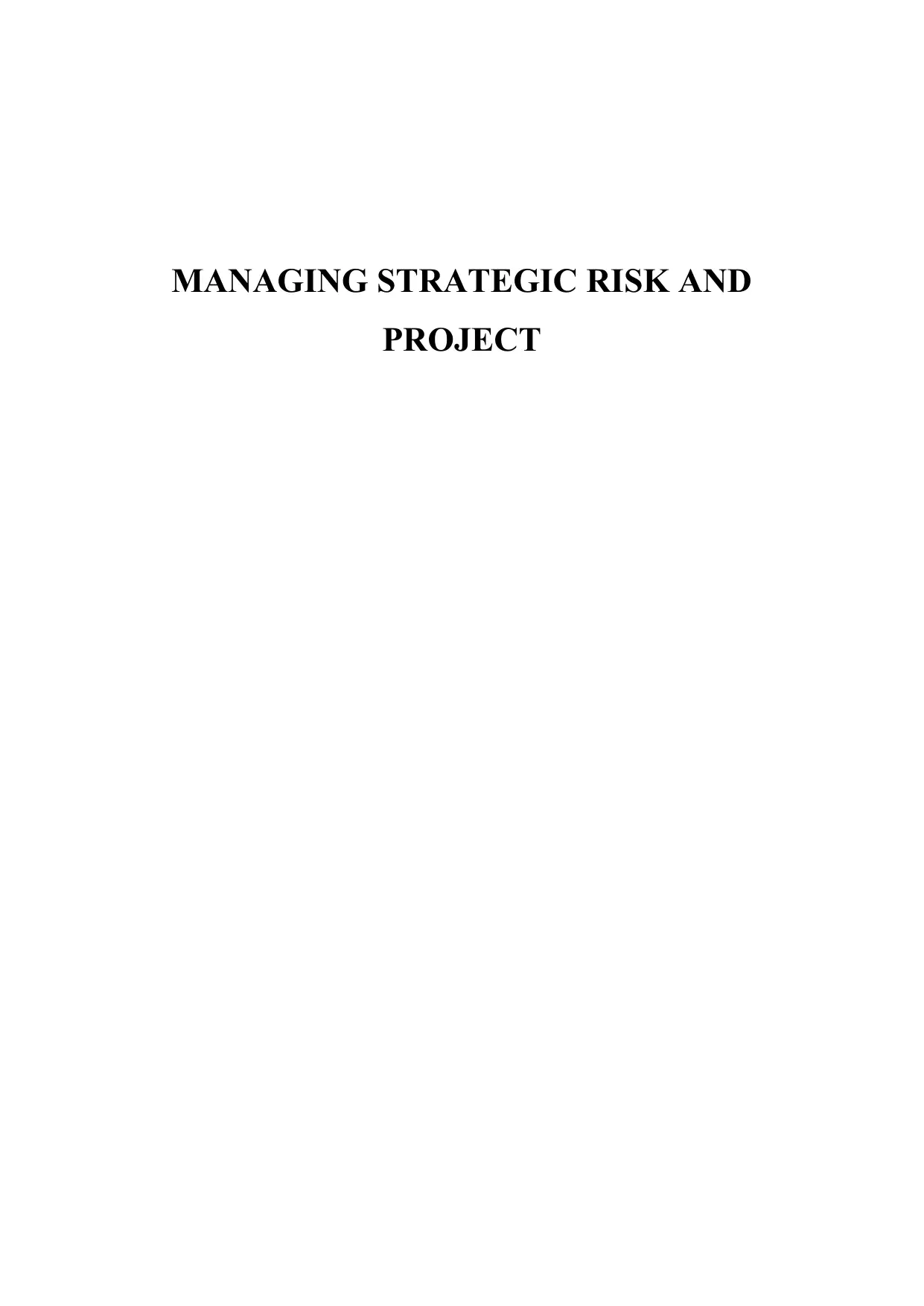
MANAGING STRATEGIC RISK AND
PROJECT
PROJECT
Paraphrase This Document
Need a fresh take? Get an instant paraphrase of this document with our AI Paraphraser
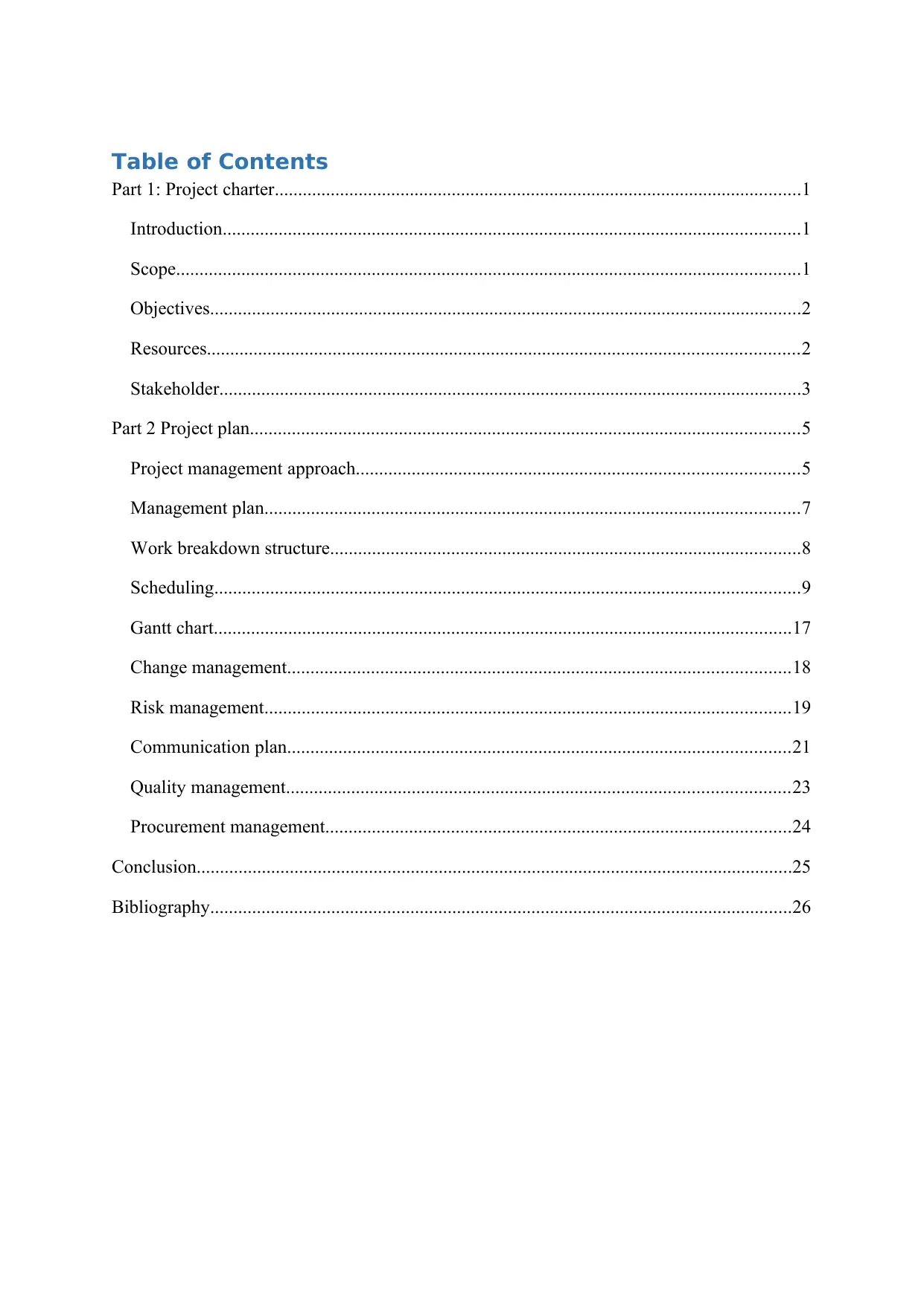
Table of Contents
Part 1: Project charter.................................................................................................................1
Introduction............................................................................................................................1
Scope......................................................................................................................................1
Objectives...............................................................................................................................2
Resources...............................................................................................................................2
Stakeholder.............................................................................................................................3
Part 2 Project plan......................................................................................................................5
Project management approach...............................................................................................5
Management plan...................................................................................................................7
Work breakdown structure.....................................................................................................8
Scheduling..............................................................................................................................9
Gantt chart............................................................................................................................17
Change management............................................................................................................18
Risk management.................................................................................................................19
Communication plan............................................................................................................21
Quality management............................................................................................................23
Procurement management....................................................................................................24
Conclusion................................................................................................................................25
Bibliography.............................................................................................................................26
Part 1: Project charter.................................................................................................................1
Introduction............................................................................................................................1
Scope......................................................................................................................................1
Objectives...............................................................................................................................2
Resources...............................................................................................................................2
Stakeholder.............................................................................................................................3
Part 2 Project plan......................................................................................................................5
Project management approach...............................................................................................5
Management plan...................................................................................................................7
Work breakdown structure.....................................................................................................8
Scheduling..............................................................................................................................9
Gantt chart............................................................................................................................17
Change management............................................................................................................18
Risk management.................................................................................................................19
Communication plan............................................................................................................21
Quality management............................................................................................................23
Procurement management....................................................................................................24
Conclusion................................................................................................................................25
Bibliography.............................................................................................................................26

List of figures
Figure 1: Waterfall approach.....................................................................................................5
Figure 2: WBS............................................................................................................................8
Figure 3: Gantt chart................................................................................................................17
Figure 1: Waterfall approach.....................................................................................................5
Figure 2: WBS............................................................................................................................8
Figure 3: Gantt chart................................................................................................................17
⊘ This is a preview!⊘
Do you want full access?
Subscribe today to unlock all pages.

Trusted by 1+ million students worldwide

List of tables
Table 1: Resource.......................................................................................................................2
Table 2: Risk register...............................................................................................................19
Table 3: Risk matrix.................................................................................................................20
Table 4: Communication plan..................................................................................................21
Table 1: Resource.......................................................................................................................2
Table 2: Risk register...............................................................................................................19
Table 3: Risk matrix.................................................................................................................20
Table 4: Communication plan..................................................................................................21
Paraphrase This Document
Need a fresh take? Get an instant paraphrase of this document with our AI Paraphraser
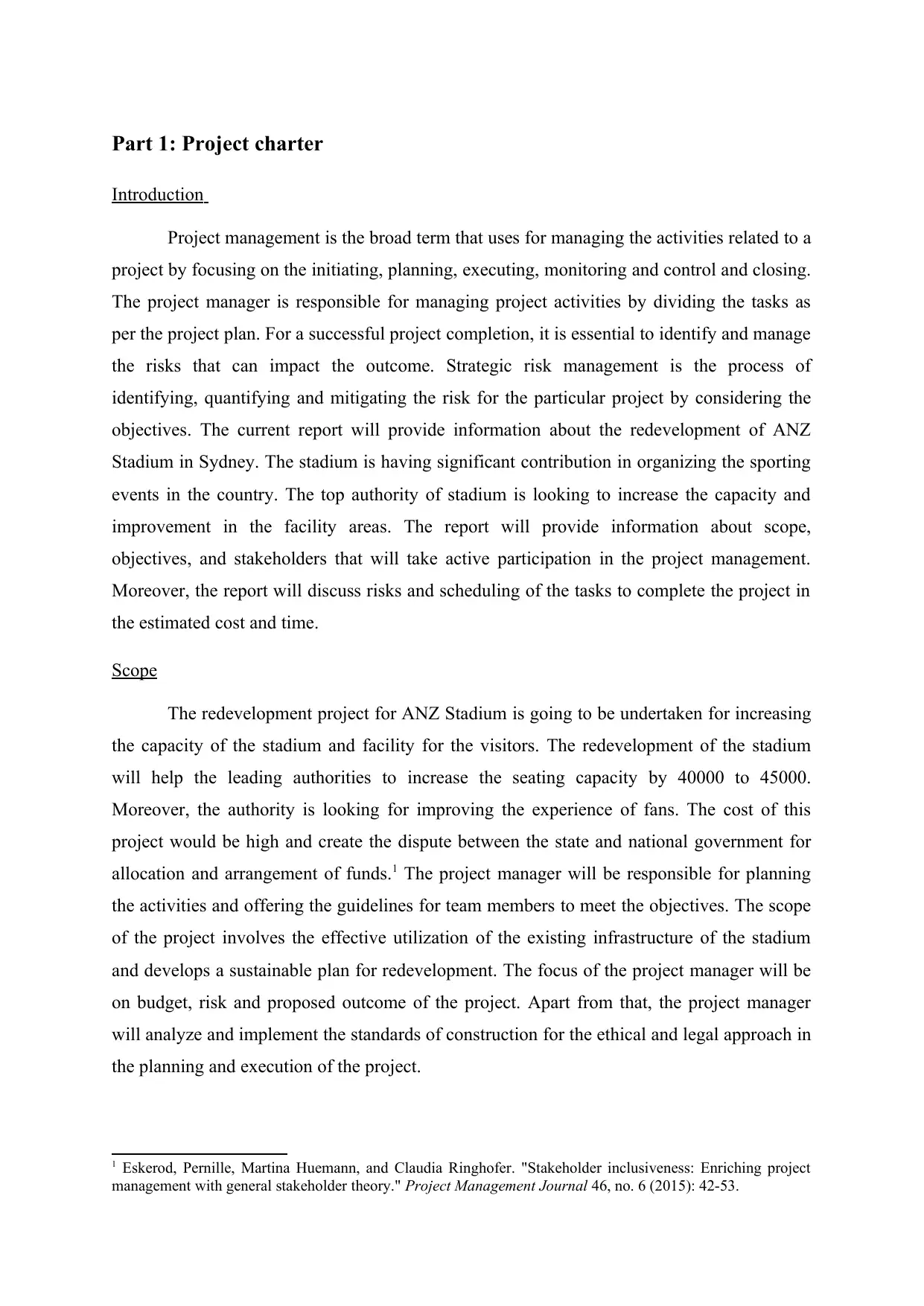
Part 1: Project charter
Introduction
Project management is the broad term that uses for managing the activities related to a
project by focusing on the initiating, planning, executing, monitoring and control and closing.
The project manager is responsible for managing project activities by dividing the tasks as
per the project plan. For a successful project completion, it is essential to identify and manage
the risks that can impact the outcome. Strategic risk management is the process of
identifying, quantifying and mitigating the risk for the particular project by considering the
objectives. The current report will provide information about the redevelopment of ANZ
Stadium in Sydney. The stadium is having significant contribution in organizing the sporting
events in the country. The top authority of stadium is looking to increase the capacity and
improvement in the facility areas. The report will provide information about scope,
objectives, and stakeholders that will take active participation in the project management.
Moreover, the report will discuss risks and scheduling of the tasks to complete the project in
the estimated cost and time.
Scope
The redevelopment project for ANZ Stadium is going to be undertaken for increasing
the capacity of the stadium and facility for the visitors. The redevelopment of the stadium
will help the leading authorities to increase the seating capacity by 40000 to 45000.
Moreover, the authority is looking for improving the experience of fans. The cost of this
project would be high and create the dispute between the state and national government for
allocation and arrangement of funds.1 The project manager will be responsible for planning
the activities and offering the guidelines for team members to meet the objectives. The scope
of the project involves the effective utilization of the existing infrastructure of the stadium
and develops a sustainable plan for redevelopment. The focus of the project manager will be
on budget, risk and proposed outcome of the project. Apart from that, the project manager
will analyze and implement the standards of construction for the ethical and legal approach in
the planning and execution of the project.
1 Eskerod, Pernille, Martina Huemann, and Claudia Ringhofer. "Stakeholder inclusiveness: Enriching project
management with general stakeholder theory." Project Management Journal 46, no. 6 (2015): 42-53.
Introduction
Project management is the broad term that uses for managing the activities related to a
project by focusing on the initiating, planning, executing, monitoring and control and closing.
The project manager is responsible for managing project activities by dividing the tasks as
per the project plan. For a successful project completion, it is essential to identify and manage
the risks that can impact the outcome. Strategic risk management is the process of
identifying, quantifying and mitigating the risk for the particular project by considering the
objectives. The current report will provide information about the redevelopment of ANZ
Stadium in Sydney. The stadium is having significant contribution in organizing the sporting
events in the country. The top authority of stadium is looking to increase the capacity and
improvement in the facility areas. The report will provide information about scope,
objectives, and stakeholders that will take active participation in the project management.
Moreover, the report will discuss risks and scheduling of the tasks to complete the project in
the estimated cost and time.
Scope
The redevelopment project for ANZ Stadium is going to be undertaken for increasing
the capacity of the stadium and facility for the visitors. The redevelopment of the stadium
will help the leading authorities to increase the seating capacity by 40000 to 45000.
Moreover, the authority is looking for improving the experience of fans. The cost of this
project would be high and create the dispute between the state and national government for
allocation and arrangement of funds.1 The project manager will be responsible for planning
the activities and offering the guidelines for team members to meet the objectives. The scope
of the project involves the effective utilization of the existing infrastructure of the stadium
and develops a sustainable plan for redevelopment. The focus of the project manager will be
on budget, risk and proposed outcome of the project. Apart from that, the project manager
will analyze and implement the standards of construction for the ethical and legal approach in
the planning and execution of the project.
1 Eskerod, Pernille, Martina Huemann, and Claudia Ringhofer. "Stakeholder inclusiveness: Enriching project
management with general stakeholder theory." Project Management Journal 46, no. 6 (2015): 42-53.
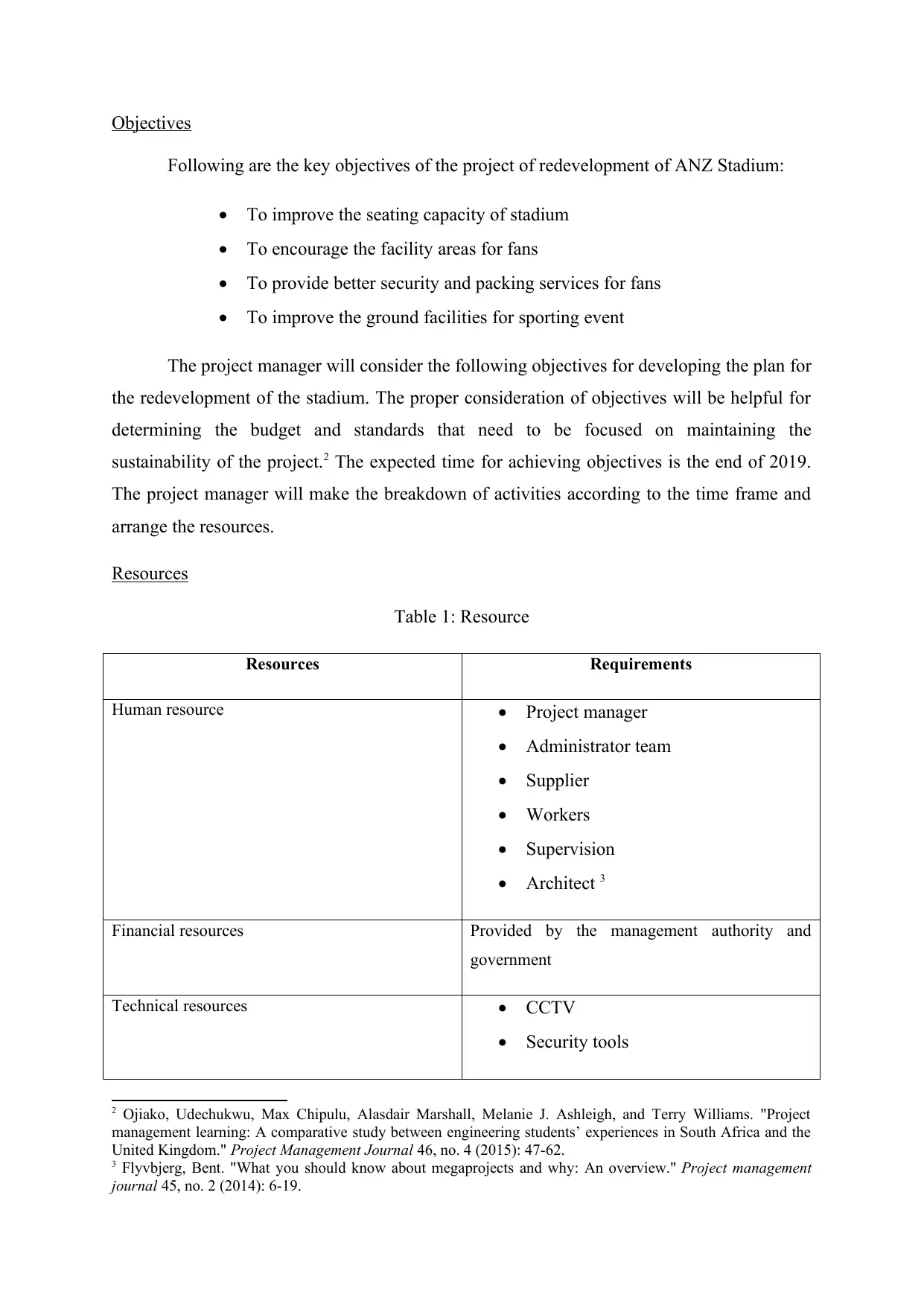
Objectives
Following are the key objectives of the project of redevelopment of ANZ Stadium:
To improve the seating capacity of stadium
To encourage the facility areas for fans
To provide better security and packing services for fans
To improve the ground facilities for sporting event
The project manager will consider the following objectives for developing the plan for
the redevelopment of the stadium. The proper consideration of objectives will be helpful for
determining the budget and standards that need to be focused on maintaining the
sustainability of the project.2 The expected time for achieving objectives is the end of 2019.
The project manager will make the breakdown of activities according to the time frame and
arrange the resources.
Resources
Table 1: Resource
Resources Requirements
Human resource Project manager
Administrator team
Supplier
Workers
Supervision
Architect 3
Financial resources Provided by the management authority and
government
Technical resources CCTV
Security tools
2 Ojiako, Udechukwu, Max Chipulu, Alasdair Marshall, Melanie J. Ashleigh, and Terry Williams. "Project
management learning: A comparative study between engineering students’ experiences in South Africa and the
United Kingdom." Project Management Journal 46, no. 4 (2015): 47-62.
3 Flyvbjerg, Bent. "What you should know about megaprojects and why: An overview." Project management
journal 45, no. 2 (2014): 6-19.
Following are the key objectives of the project of redevelopment of ANZ Stadium:
To improve the seating capacity of stadium
To encourage the facility areas for fans
To provide better security and packing services for fans
To improve the ground facilities for sporting event
The project manager will consider the following objectives for developing the plan for
the redevelopment of the stadium. The proper consideration of objectives will be helpful for
determining the budget and standards that need to be focused on maintaining the
sustainability of the project.2 The expected time for achieving objectives is the end of 2019.
The project manager will make the breakdown of activities according to the time frame and
arrange the resources.
Resources
Table 1: Resource
Resources Requirements
Human resource Project manager
Administrator team
Supplier
Workers
Supervision
Architect 3
Financial resources Provided by the management authority and
government
Technical resources CCTV
Security tools
2 Ojiako, Udechukwu, Max Chipulu, Alasdair Marshall, Melanie J. Ashleigh, and Terry Williams. "Project
management learning: A comparative study between engineering students’ experiences in South Africa and the
United Kingdom." Project Management Journal 46, no. 4 (2015): 47-62.
3 Flyvbjerg, Bent. "What you should know about megaprojects and why: An overview." Project management
journal 45, no. 2 (2014): 6-19.
⊘ This is a preview!⊘
Do you want full access?
Subscribe today to unlock all pages.

Trusted by 1+ million students worldwide
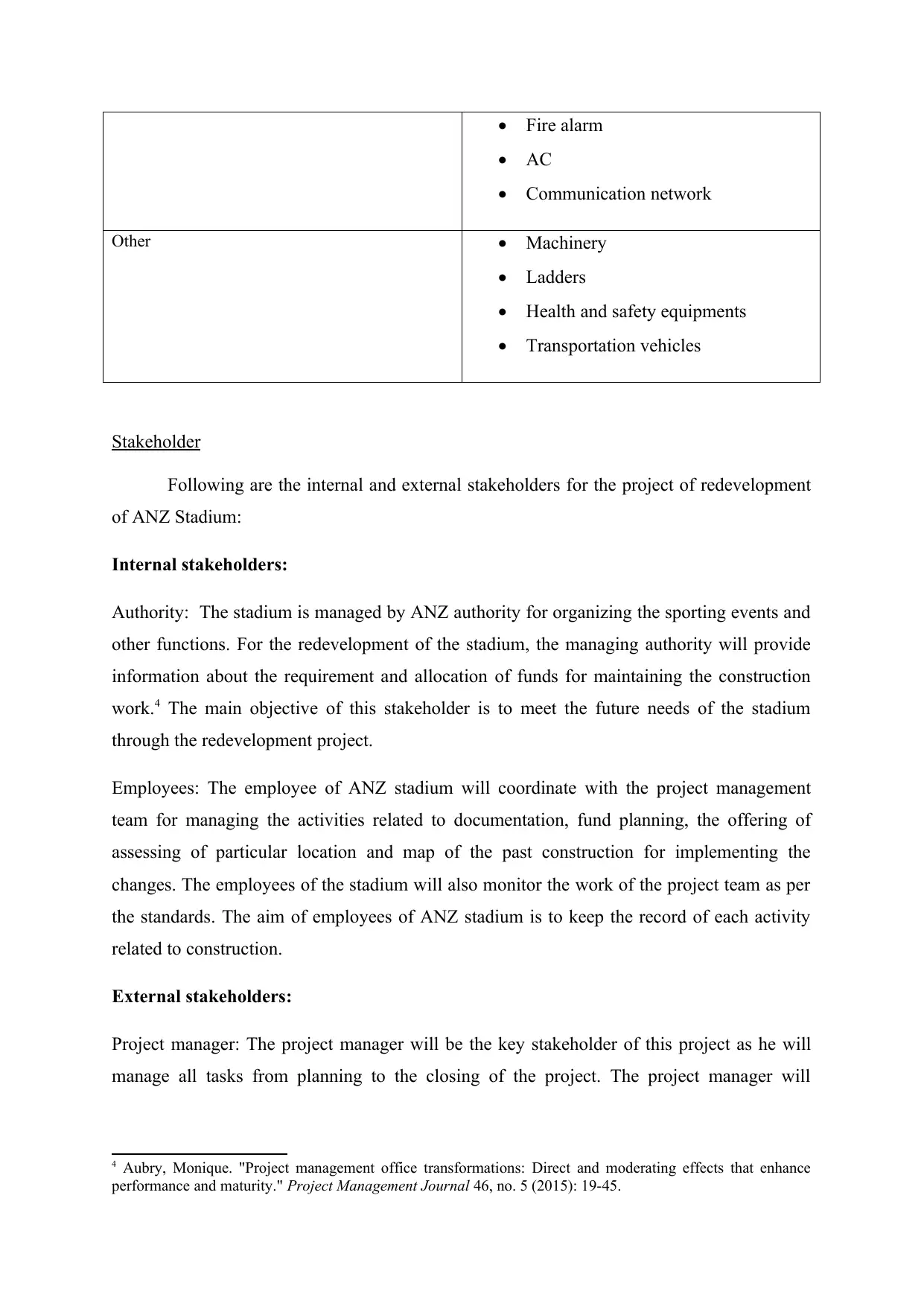
Fire alarm
AC
Communication network
Other Machinery
Ladders
Health and safety equipments
Transportation vehicles
Stakeholder
Following are the internal and external stakeholders for the project of redevelopment
of ANZ Stadium:
Internal stakeholders:
Authority: The stadium is managed by ANZ authority for organizing the sporting events and
other functions. For the redevelopment of the stadium, the managing authority will provide
information about the requirement and allocation of funds for maintaining the construction
work.4 The main objective of this stakeholder is to meet the future needs of the stadium
through the redevelopment project.
Employees: The employee of ANZ stadium will coordinate with the project management
team for managing the activities related to documentation, fund planning, the offering of
assessing of particular location and map of the past construction for implementing the
changes. The employees of the stadium will also monitor the work of the project team as per
the standards. The aim of employees of ANZ stadium is to keep the record of each activity
related to construction.
External stakeholders:
Project manager: The project manager will be the key stakeholder of this project as he will
manage all tasks from planning to the closing of the project. The project manager will
4 Aubry, Monique. "Project management office transformations: Direct and moderating effects that enhance
performance and maturity." Project Management Journal 46, no. 5 (2015): 19-45.
AC
Communication network
Other Machinery
Ladders
Health and safety equipments
Transportation vehicles
Stakeholder
Following are the internal and external stakeholders for the project of redevelopment
of ANZ Stadium:
Internal stakeholders:
Authority: The stadium is managed by ANZ authority for organizing the sporting events and
other functions. For the redevelopment of the stadium, the managing authority will provide
information about the requirement and allocation of funds for maintaining the construction
work.4 The main objective of this stakeholder is to meet the future needs of the stadium
through the redevelopment project.
Employees: The employee of ANZ stadium will coordinate with the project management
team for managing the activities related to documentation, fund planning, the offering of
assessing of particular location and map of the past construction for implementing the
changes. The employees of the stadium will also monitor the work of the project team as per
the standards. The aim of employees of ANZ stadium is to keep the record of each activity
related to construction.
External stakeholders:
Project manager: The project manager will be the key stakeholder of this project as he will
manage all tasks from planning to the closing of the project. The project manager will
4 Aubry, Monique. "Project management office transformations: Direct and moderating effects that enhance
performance and maturity." Project Management Journal 46, no. 5 (2015): 19-45.
Paraphrase This Document
Need a fresh take? Get an instant paraphrase of this document with our AI Paraphraser
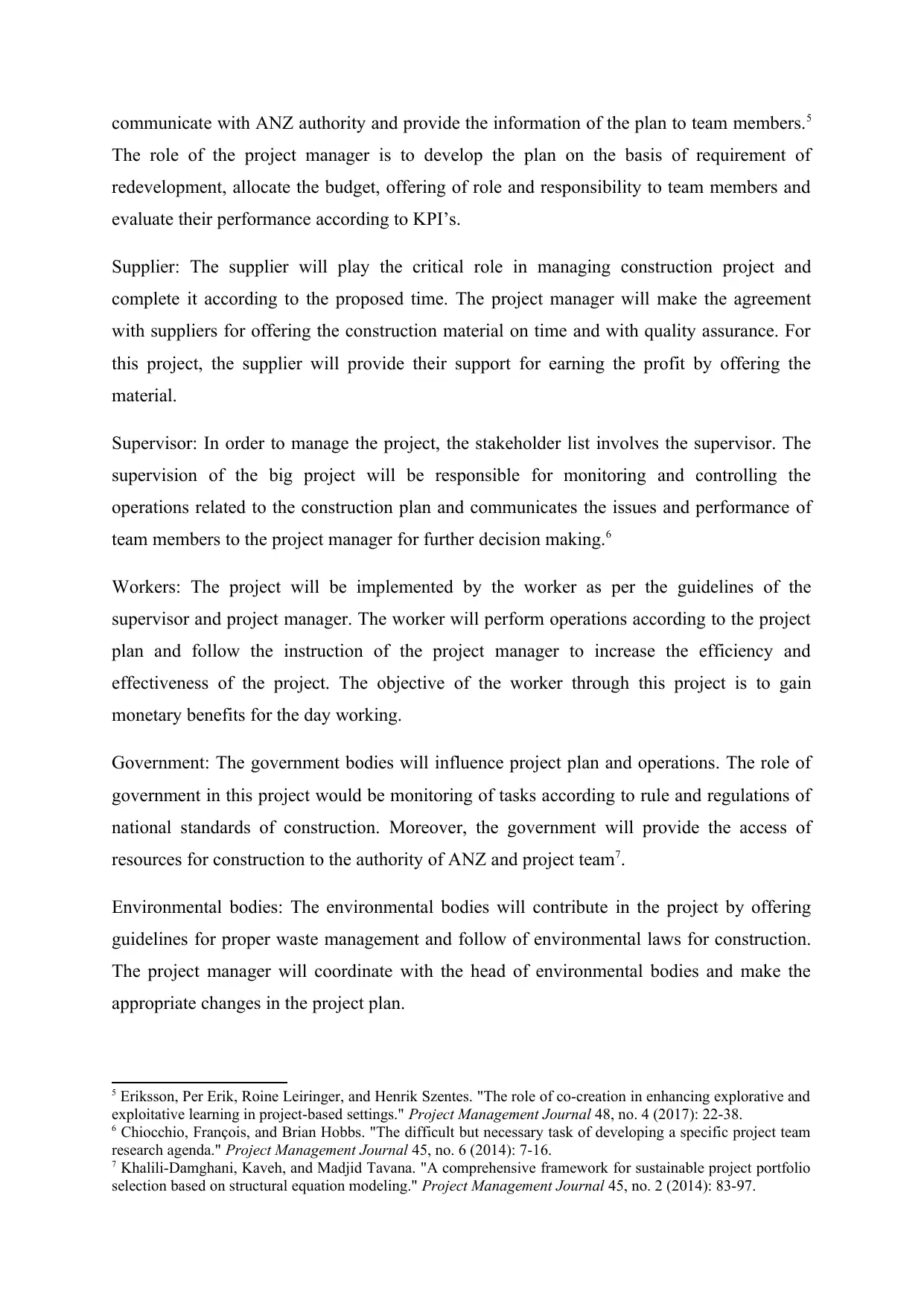
communicate with ANZ authority and provide the information of the plan to team members.5
The role of the project manager is to develop the plan on the basis of requirement of
redevelopment, allocate the budget, offering of role and responsibility to team members and
evaluate their performance according to KPI’s.
Supplier: The supplier will play the critical role in managing construction project and
complete it according to the proposed time. The project manager will make the agreement
with suppliers for offering the construction material on time and with quality assurance. For
this project, the supplier will provide their support for earning the profit by offering the
material.
Supervisor: In order to manage the project, the stakeholder list involves the supervisor. The
supervision of the big project will be responsible for monitoring and controlling the
operations related to the construction plan and communicates the issues and performance of
team members to the project manager for further decision making.6
Workers: The project will be implemented by the worker as per the guidelines of the
supervisor and project manager. The worker will perform operations according to the project
plan and follow the instruction of the project manager to increase the efficiency and
effectiveness of the project. The objective of the worker through this project is to gain
monetary benefits for the day working.
Government: The government bodies will influence project plan and operations. The role of
government in this project would be monitoring of tasks according to rule and regulations of
national standards of construction. Moreover, the government will provide the access of
resources for construction to the authority of ANZ and project team7.
Environmental bodies: The environmental bodies will contribute in the project by offering
guidelines for proper waste management and follow of environmental laws for construction.
The project manager will coordinate with the head of environmental bodies and make the
appropriate changes in the project plan.
5 Eriksson, Per Erik, Roine Leiringer, and Henrik Szentes. "The role of co-creation in enhancing explorative and
exploitative learning in project-based settings." Project Management Journal 48, no. 4 (2017): 22-38.
6 Chiocchio, François, and Brian Hobbs. "The difficult but necessary task of developing a specific project team
research agenda." Project Management Journal 45, no. 6 (2014): 7-16.
7 Khalili-Damghani, Kaveh, and Madjid Tavana. "A comprehensive framework for sustainable project portfolio
selection based on structural equation modeling." Project Management Journal 45, no. 2 (2014): 83-97.
The role of the project manager is to develop the plan on the basis of requirement of
redevelopment, allocate the budget, offering of role and responsibility to team members and
evaluate their performance according to KPI’s.
Supplier: The supplier will play the critical role in managing construction project and
complete it according to the proposed time. The project manager will make the agreement
with suppliers for offering the construction material on time and with quality assurance. For
this project, the supplier will provide their support for earning the profit by offering the
material.
Supervisor: In order to manage the project, the stakeholder list involves the supervisor. The
supervision of the big project will be responsible for monitoring and controlling the
operations related to the construction plan and communicates the issues and performance of
team members to the project manager for further decision making.6
Workers: The project will be implemented by the worker as per the guidelines of the
supervisor and project manager. The worker will perform operations according to the project
plan and follow the instruction of the project manager to increase the efficiency and
effectiveness of the project. The objective of the worker through this project is to gain
monetary benefits for the day working.
Government: The government bodies will influence project plan and operations. The role of
government in this project would be monitoring of tasks according to rule and regulations of
national standards of construction. Moreover, the government will provide the access of
resources for construction to the authority of ANZ and project team7.
Environmental bodies: The environmental bodies will contribute in the project by offering
guidelines for proper waste management and follow of environmental laws for construction.
The project manager will coordinate with the head of environmental bodies and make the
appropriate changes in the project plan.
5 Eriksson, Per Erik, Roine Leiringer, and Henrik Szentes. "The role of co-creation in enhancing explorative and
exploitative learning in project-based settings." Project Management Journal 48, no. 4 (2017): 22-38.
6 Chiocchio, François, and Brian Hobbs. "The difficult but necessary task of developing a specific project team
research agenda." Project Management Journal 45, no. 6 (2014): 7-16.
7 Khalili-Damghani, Kaveh, and Madjid Tavana. "A comprehensive framework for sustainable project portfolio
selection based on structural equation modeling." Project Management Journal 45, no. 2 (2014): 83-97.
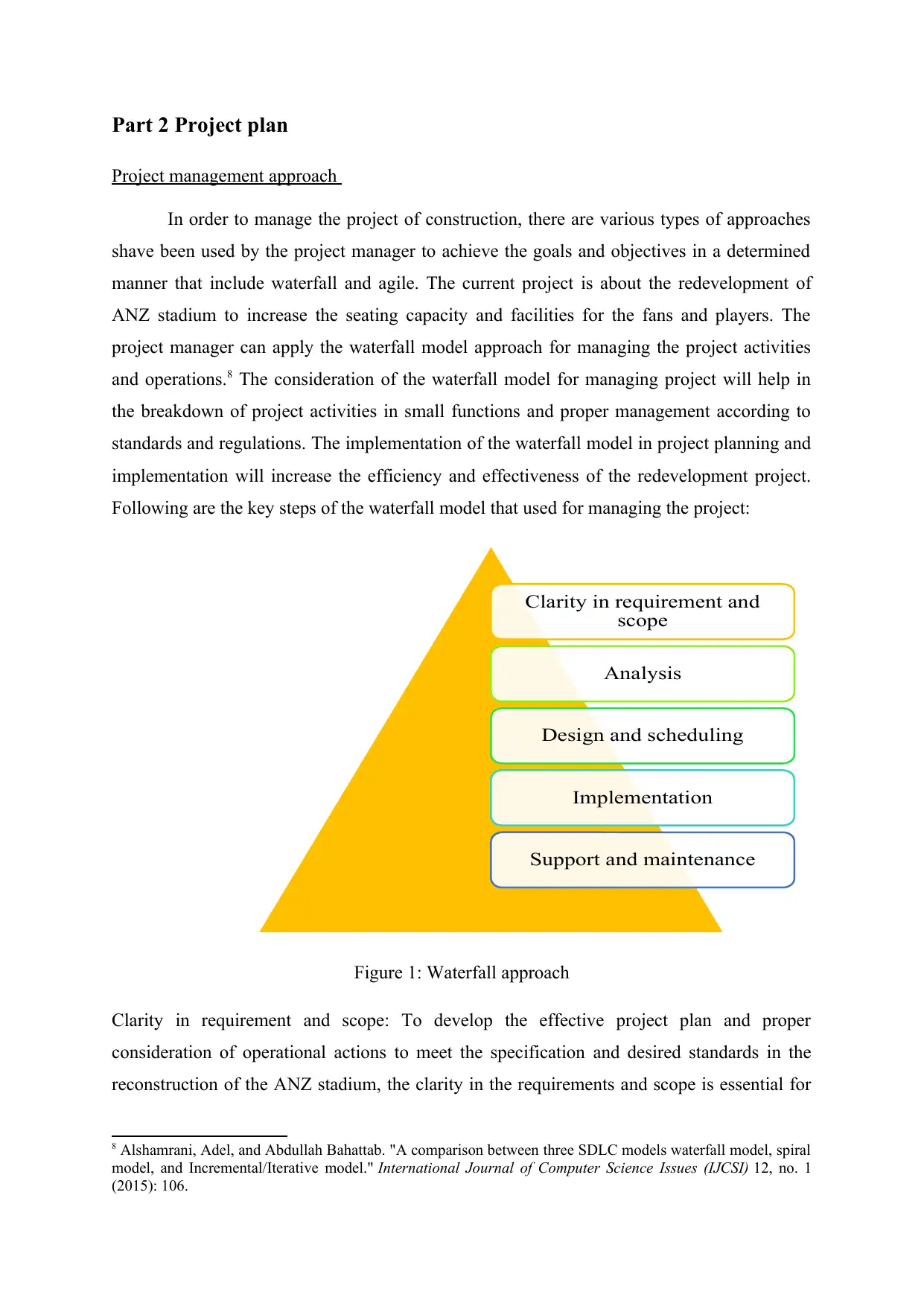
Part 2 Project plan
Project management approach
In order to manage the project of construction, there are various types of approaches
shave been used by the project manager to achieve the goals and objectives in a determined
manner that include waterfall and agile. The current project is about the redevelopment of
ANZ stadium to increase the seating capacity and facilities for the fans and players. The
project manager can apply the waterfall model approach for managing the project activities
and operations.8 The consideration of the waterfall model for managing project will help in
the breakdown of project activities in small functions and proper management according to
standards and regulations. The implementation of the waterfall model in project planning and
implementation will increase the efficiency and effectiveness of the redevelopment project.
Following are the key steps of the waterfall model that used for managing the project:
Figure 1: Waterfall approach
Clarity in requirement and scope: To develop the effective project plan and proper
consideration of operational actions to meet the specification and desired standards in the
reconstruction of the ANZ stadium, the clarity in the requirements and scope is essential for
8 Alshamrani, Adel, and Abdullah Bahattab. "A comparison between three SDLC models waterfall model, spiral
model, and Incremental/Iterative model." International Journal of Computer Science Issues (IJCSI) 12, no. 1
(2015): 106.
Clarity in requirement and
scope
Analysis
Design and scheduling
Implementation
Support and maintenance
Project management approach
In order to manage the project of construction, there are various types of approaches
shave been used by the project manager to achieve the goals and objectives in a determined
manner that include waterfall and agile. The current project is about the redevelopment of
ANZ stadium to increase the seating capacity and facilities for the fans and players. The
project manager can apply the waterfall model approach for managing the project activities
and operations.8 The consideration of the waterfall model for managing project will help in
the breakdown of project activities in small functions and proper management according to
standards and regulations. The implementation of the waterfall model in project planning and
implementation will increase the efficiency and effectiveness of the redevelopment project.
Following are the key steps of the waterfall model that used for managing the project:
Figure 1: Waterfall approach
Clarity in requirement and scope: To develop the effective project plan and proper
consideration of operational actions to meet the specification and desired standards in the
reconstruction of the ANZ stadium, the clarity in the requirements and scope is essential for
8 Alshamrani, Adel, and Abdullah Bahattab. "A comparison between three SDLC models waterfall model, spiral
model, and Incremental/Iterative model." International Journal of Computer Science Issues (IJCSI) 12, no. 1
(2015): 106.
Clarity in requirement and
scope
Analysis
Design and scheduling
Implementation
Support and maintenance
⊘ This is a preview!⊘
Do you want full access?
Subscribe today to unlock all pages.

Trusted by 1+ million students worldwide
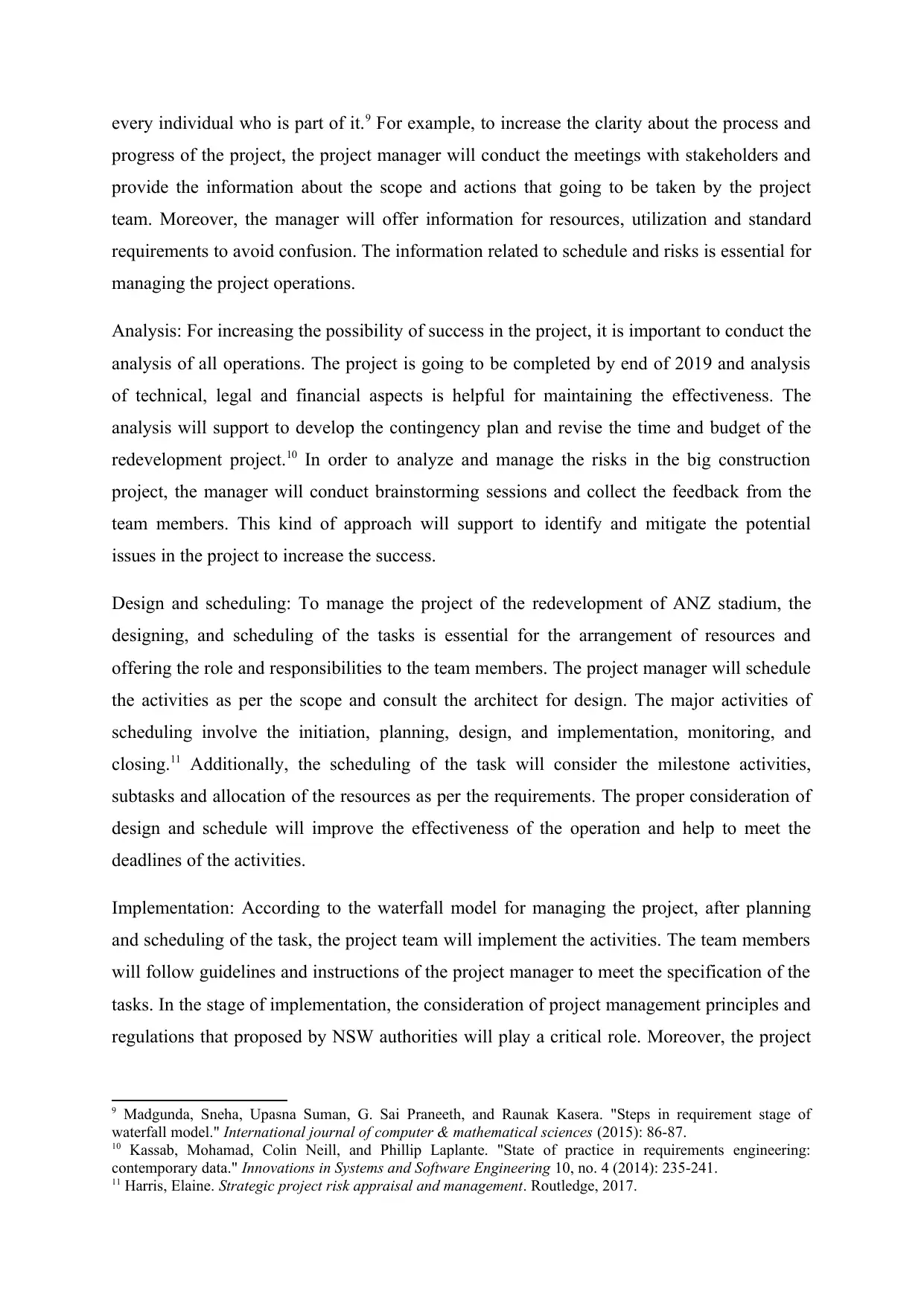
every individual who is part of it.9 For example, to increase the clarity about the process and
progress of the project, the project manager will conduct the meetings with stakeholders and
provide the information about the scope and actions that going to be taken by the project
team. Moreover, the manager will offer information for resources, utilization and standard
requirements to avoid confusion. The information related to schedule and risks is essential for
managing the project operations.
Analysis: For increasing the possibility of success in the project, it is important to conduct the
analysis of all operations. The project is going to be completed by end of 2019 and analysis
of technical, legal and financial aspects is helpful for maintaining the effectiveness. The
analysis will support to develop the contingency plan and revise the time and budget of the
redevelopment project.10 In order to analyze and manage the risks in the big construction
project, the manager will conduct brainstorming sessions and collect the feedback from the
team members. This kind of approach will support to identify and mitigate the potential
issues in the project to increase the success.
Design and scheduling: To manage the project of the redevelopment of ANZ stadium, the
designing, and scheduling of the tasks is essential for the arrangement of resources and
offering the role and responsibilities to the team members. The project manager will schedule
the activities as per the scope and consult the architect for design. The major activities of
scheduling involve the initiation, planning, design, and implementation, monitoring, and
closing.11 Additionally, the scheduling of the task will consider the milestone activities,
subtasks and allocation of the resources as per the requirements. The proper consideration of
design and schedule will improve the effectiveness of the operation and help to meet the
deadlines of the activities.
Implementation: According to the waterfall model for managing the project, after planning
and scheduling of the task, the project team will implement the activities. The team members
will follow guidelines and instructions of the project manager to meet the specification of the
tasks. In the stage of implementation, the consideration of project management principles and
regulations that proposed by NSW authorities will play a critical role. Moreover, the project
9 Madgunda, Sneha, Upasna Suman, G. Sai Praneeth, and Raunak Kasera. "Steps in requirement stage of
waterfall model." International journal of computer & mathematical sciences (2015): 86-87.
10 Kassab, Mohamad, Colin Neill, and Phillip Laplante. "State of practice in requirements engineering:
contemporary data." Innovations in Systems and Software Engineering 10, no. 4 (2014): 235-241.
11 Harris, Elaine. Strategic project risk appraisal and management. Routledge, 2017.
progress of the project, the project manager will conduct the meetings with stakeholders and
provide the information about the scope and actions that going to be taken by the project
team. Moreover, the manager will offer information for resources, utilization and standard
requirements to avoid confusion. The information related to schedule and risks is essential for
managing the project operations.
Analysis: For increasing the possibility of success in the project, it is important to conduct the
analysis of all operations. The project is going to be completed by end of 2019 and analysis
of technical, legal and financial aspects is helpful for maintaining the effectiveness. The
analysis will support to develop the contingency plan and revise the time and budget of the
redevelopment project.10 In order to analyze and manage the risks in the big construction
project, the manager will conduct brainstorming sessions and collect the feedback from the
team members. This kind of approach will support to identify and mitigate the potential
issues in the project to increase the success.
Design and scheduling: To manage the project of the redevelopment of ANZ stadium, the
designing, and scheduling of the tasks is essential for the arrangement of resources and
offering the role and responsibilities to the team members. The project manager will schedule
the activities as per the scope and consult the architect for design. The major activities of
scheduling involve the initiation, planning, design, and implementation, monitoring, and
closing.11 Additionally, the scheduling of the task will consider the milestone activities,
subtasks and allocation of the resources as per the requirements. The proper consideration of
design and schedule will improve the effectiveness of the operation and help to meet the
deadlines of the activities.
Implementation: According to the waterfall model for managing the project, after planning
and scheduling of the task, the project team will implement the activities. The team members
will follow guidelines and instructions of the project manager to meet the specification of the
tasks. In the stage of implementation, the consideration of project management principles and
regulations that proposed by NSW authorities will play a critical role. Moreover, the project
9 Madgunda, Sneha, Upasna Suman, G. Sai Praneeth, and Raunak Kasera. "Steps in requirement stage of
waterfall model." International journal of computer & mathematical sciences (2015): 86-87.
10 Kassab, Mohamad, Colin Neill, and Phillip Laplante. "State of practice in requirements engineering:
contemporary data." Innovations in Systems and Software Engineering 10, no. 4 (2014): 235-241.
11 Harris, Elaine. Strategic project risk appraisal and management. Routledge, 2017.
Paraphrase This Document
Need a fresh take? Get an instant paraphrase of this document with our AI Paraphraser
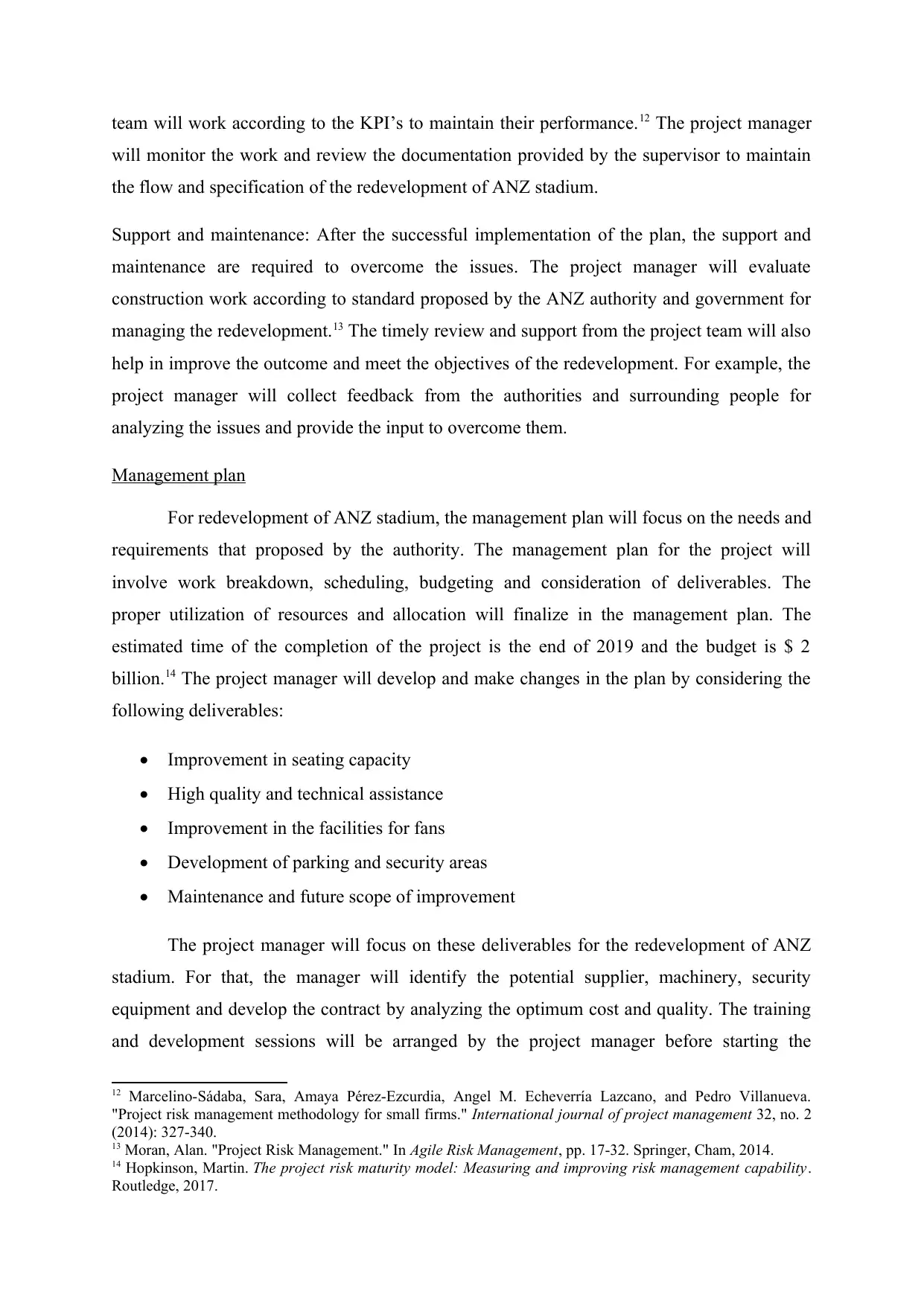
team will work according to the KPI’s to maintain their performance.12 The project manager
will monitor the work and review the documentation provided by the supervisor to maintain
the flow and specification of the redevelopment of ANZ stadium.
Support and maintenance: After the successful implementation of the plan, the support and
maintenance are required to overcome the issues. The project manager will evaluate
construction work according to standard proposed by the ANZ authority and government for
managing the redevelopment.13 The timely review and support from the project team will also
help in improve the outcome and meet the objectives of the redevelopment. For example, the
project manager will collect feedback from the authorities and surrounding people for
analyzing the issues and provide the input to overcome them.
Management plan
For redevelopment of ANZ stadium, the management plan will focus on the needs and
requirements that proposed by the authority. The management plan for the project will
involve work breakdown, scheduling, budgeting and consideration of deliverables. The
proper utilization of resources and allocation will finalize in the management plan. The
estimated time of the completion of the project is the end of 2019 and the budget is $ 2
billion.14 The project manager will develop and make changes in the plan by considering the
following deliverables:
Improvement in seating capacity
High quality and technical assistance
Improvement in the facilities for fans
Development of parking and security areas
Maintenance and future scope of improvement
The project manager will focus on these deliverables for the redevelopment of ANZ
stadium. For that, the manager will identify the potential supplier, machinery, security
equipment and develop the contract by analyzing the optimum cost and quality. The training
and development sessions will be arranged by the project manager before starting the
12 Marcelino-Sádaba, Sara, Amaya Pérez-Ezcurdia, Angel M. Echeverría Lazcano, and Pedro Villanueva.
"Project risk management methodology for small firms." International journal of project management 32, no. 2
(2014): 327-340.
13 Moran, Alan. "Project Risk Management." In Agile Risk Management, pp. 17-32. Springer, Cham, 2014.
14 Hopkinson, Martin. The project risk maturity model: Measuring and improving risk management capability.
Routledge, 2017.
will monitor the work and review the documentation provided by the supervisor to maintain
the flow and specification of the redevelopment of ANZ stadium.
Support and maintenance: After the successful implementation of the plan, the support and
maintenance are required to overcome the issues. The project manager will evaluate
construction work according to standard proposed by the ANZ authority and government for
managing the redevelopment.13 The timely review and support from the project team will also
help in improve the outcome and meet the objectives of the redevelopment. For example, the
project manager will collect feedback from the authorities and surrounding people for
analyzing the issues and provide the input to overcome them.
Management plan
For redevelopment of ANZ stadium, the management plan will focus on the needs and
requirements that proposed by the authority. The management plan for the project will
involve work breakdown, scheduling, budgeting and consideration of deliverables. The
proper utilization of resources and allocation will finalize in the management plan. The
estimated time of the completion of the project is the end of 2019 and the budget is $ 2
billion.14 The project manager will develop and make changes in the plan by considering the
following deliverables:
Improvement in seating capacity
High quality and technical assistance
Improvement in the facilities for fans
Development of parking and security areas
Maintenance and future scope of improvement
The project manager will focus on these deliverables for the redevelopment of ANZ
stadium. For that, the manager will identify the potential supplier, machinery, security
equipment and develop the contract by analyzing the optimum cost and quality. The training
and development sessions will be arranged by the project manager before starting the
12 Marcelino-Sádaba, Sara, Amaya Pérez-Ezcurdia, Angel M. Echeverría Lazcano, and Pedro Villanueva.
"Project risk management methodology for small firms." International journal of project management 32, no. 2
(2014): 327-340.
13 Moran, Alan. "Project Risk Management." In Agile Risk Management, pp. 17-32. Springer, Cham, 2014.
14 Hopkinson, Martin. The project risk maturity model: Measuring and improving risk management capability.
Routledge, 2017.
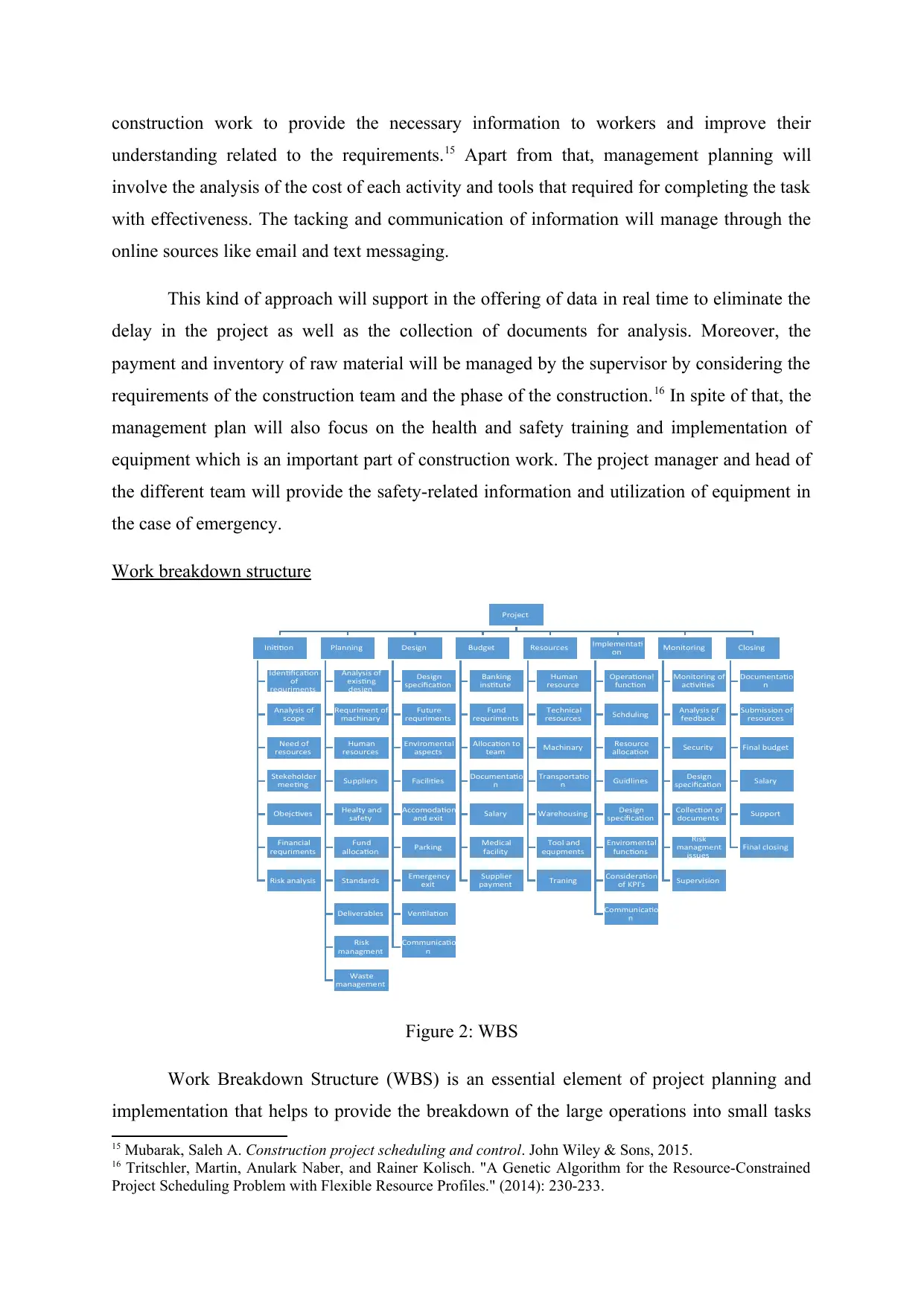
construction work to provide the necessary information to workers and improve their
understanding related to the requirements.15 Apart from that, management planning will
involve the analysis of the cost of each activity and tools that required for completing the task
with effectiveness. The tacking and communication of information will manage through the
online sources like email and text messaging.
This kind of approach will support in the offering of data in real time to eliminate the
delay in the project as well as the collection of documents for analysis. Moreover, the
payment and inventory of raw material will be managed by the supervisor by considering the
requirements of the construction team and the phase of the construction.16 In spite of that, the
management plan will also focus on the health and safety training and implementation of
equipment which is an important part of construction work. The project manager and head of
the different team will provide the safety-related information and utilization of equipment in
the case of emergency.
Work breakdown structure
Figure 2: WBS
Work Breakdown Structure (WBS) is an essential element of project planning and
implementation that helps to provide the breakdown of the large operations into small tasks
15 Mubarak, Saleh A. Construction project scheduling and control. John Wiley & Sons, 2015.
16 Tritschler, Martin, Anulark Naber, and Rainer Kolisch. "A Genetic Algorithm for the Resource-Constrained
Project Scheduling Problem with Flexible Resource Profiles." (2014): 230-233.
Project
Initition
Identification
of
requriments
Analysis of
scope
Need of
resources
Stekeholder
meeting
Obejctives
Financial
requriments
Risk analysis
Planning
Analysis of
existing
design
Requriment of
machinary
Human
resources
Suppliers
Healty and
safety
Fund
allocation
Standards
Deliverables
Risk
managment
Waste
management
Design
Design
specification
Future
requriments
Enviromental
aspects
Facilities
Accomodation
and exit
Parking
Emergency
exit
Ventilation
Communicatio
n
Budget
Banking
institute
Fund
requriments
Allocation to
team
Documentatio
n
Salary
Medical
facility
Supplier
payment
Resources
Human
resource
Technical
resources
Machinary
Transportatio
n
Warehousing
Tool and
equpments
Traning
Implementati
on
Operational
function
Schduling
Resource
allocation
Guidlines
Design
specification
Enviromental
functions
Consideration
of KPI's
Communicatio
n
Monitoring
Monitoring of
activities
Analysis of
feedback
Security
Design
specification
Collection of
documents
Risk
managment
issues
Supervision
Closing
Documentatio
n
Submission of
resources
Final budget
Salary
Support
Final closing
understanding related to the requirements.15 Apart from that, management planning will
involve the analysis of the cost of each activity and tools that required for completing the task
with effectiveness. The tacking and communication of information will manage through the
online sources like email and text messaging.
This kind of approach will support in the offering of data in real time to eliminate the
delay in the project as well as the collection of documents for analysis. Moreover, the
payment and inventory of raw material will be managed by the supervisor by considering the
requirements of the construction team and the phase of the construction.16 In spite of that, the
management plan will also focus on the health and safety training and implementation of
equipment which is an important part of construction work. The project manager and head of
the different team will provide the safety-related information and utilization of equipment in
the case of emergency.
Work breakdown structure
Figure 2: WBS
Work Breakdown Structure (WBS) is an essential element of project planning and
implementation that helps to provide the breakdown of the large operations into small tasks
15 Mubarak, Saleh A. Construction project scheduling and control. John Wiley & Sons, 2015.
16 Tritschler, Martin, Anulark Naber, and Rainer Kolisch. "A Genetic Algorithm for the Resource-Constrained
Project Scheduling Problem with Flexible Resource Profiles." (2014): 230-233.
Project
Initition
Identification
of
requriments
Analysis of
scope
Need of
resources
Stekeholder
meeting
Obejctives
Financial
requriments
Risk analysis
Planning
Analysis of
existing
design
Requriment of
machinary
Human
resources
Suppliers
Healty and
safety
Fund
allocation
Standards
Deliverables
Risk
managment
Waste
management
Design
Design
specification
Future
requriments
Enviromental
aspects
Facilities
Accomodation
and exit
Parking
Emergency
exit
Ventilation
Communicatio
n
Budget
Banking
institute
Fund
requriments
Allocation to
team
Documentatio
n
Salary
Medical
facility
Supplier
payment
Resources
Human
resource
Technical
resources
Machinary
Transportatio
n
Warehousing
Tool and
equpments
Traning
Implementati
on
Operational
function
Schduling
Resource
allocation
Guidlines
Design
specification
Enviromental
functions
Consideration
of KPI's
Communicatio
n
Monitoring
Monitoring of
activities
Analysis of
feedback
Security
Design
specification
Collection of
documents
Risk
managment
issues
Supervision
Closing
Documentatio
n
Submission of
resources
Final budget
Salary
Support
Final closing
⊘ This is a preview!⊘
Do you want full access?
Subscribe today to unlock all pages.

Trusted by 1+ million students worldwide
1 out of 34
Related Documents
Your All-in-One AI-Powered Toolkit for Academic Success.
+13062052269
info@desklib.com
Available 24*7 on WhatsApp / Email
![[object Object]](/_next/static/media/star-bottom.7253800d.svg)
Unlock your academic potential
Copyright © 2020–2025 A2Z Services. All Rights Reserved. Developed and managed by ZUCOL.



